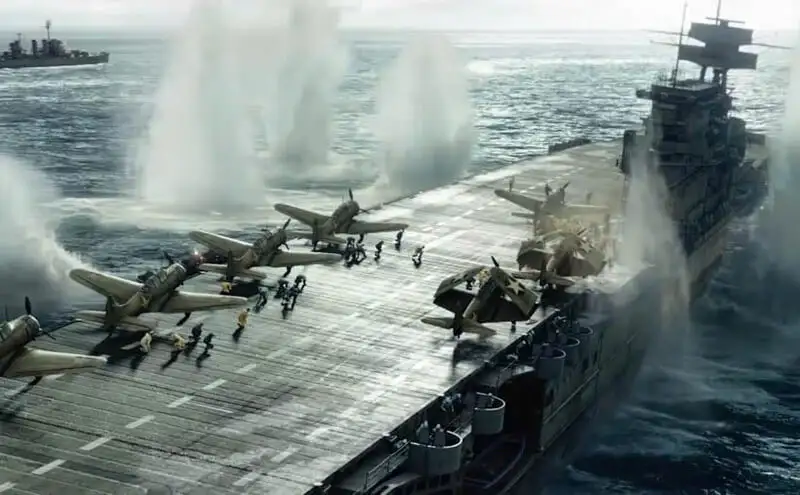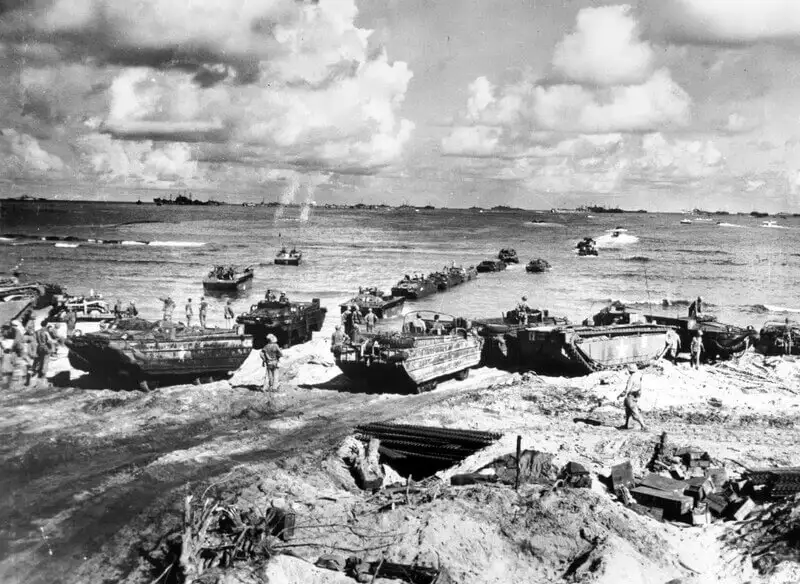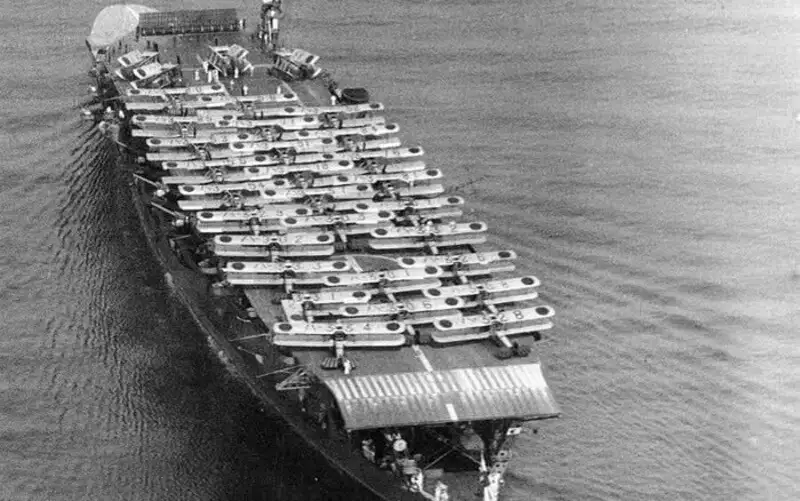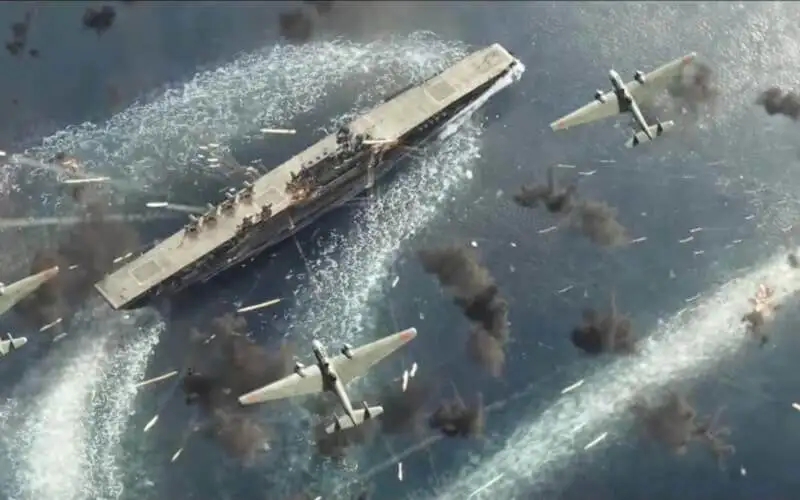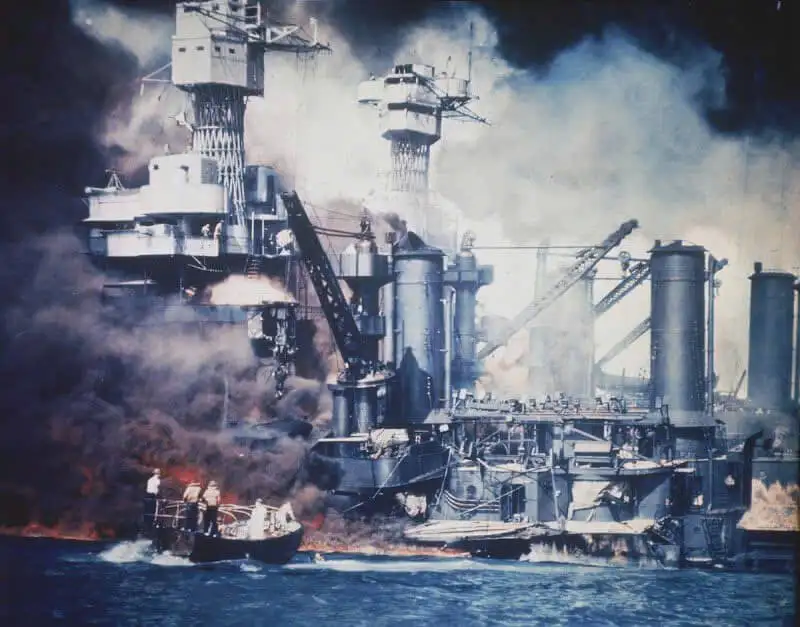The Battle of Midway was a historic clash between the United States Navy and the Imperial Japanese Navy, occurring six months after the attack on Pearl Harbor. The resounding victory of the U.S. Navy in this air and sea battle from June 3-6, 1942, shattered Japan’s ambition to neutralize American naval power and marked a crucial turning point in World War II on the Pacific front. In this article, Pywar will guide readers through the key aspects of the resounding Battle of Midway, a defining moment of World War II.
Japan’s Ambitions in the Pacific
Before the Battle of Midway, Japan had sought to establish overwhelming naval and air superiority in the western Pacific. However, these efforts began to falter during the Battle of the Coral Sea (May 1942), where the U.S. fleet repelled a Japanese invasion force headed for New Guinea.
Despite the setback at the Coral Sea, Admiral Isoroku Yamamoto, commander of the Imperial Japanese Navy, remained confident that his forces held a significant numerical advantage over the United States. Hoping to replicate the success of the Pearl Harbor attack, Yamamoto resolved to locate and destroy the remnants of the U.S. Pacific Fleet with a surprise assault on the vital Allied base at Midway Island—a strategic point in the Pacific between the United States and Japan.

- The U.S. Navy prepares its counterattack at Midway during World War II, showcasing superior preparation and strategy. (Source: Collected)
Japan’s Attack Plan
Yamamoto devised a three-pronged strategy to attack Midway:
- Air Assault: Conducted from four of Japan’s premier aircraft carriers—Akagi, Kaga, Hiryu, and Soryu—under the command of Vice Admiral Chuichi Nagumo.
- Invasion Force: Comprised of warships and troops led by Vice Admiral Nobutake Kondo.
- Ambush of U.S. Forces: As American reinforcements arrived from Pearl Harbor to defend Midway, Yamamoto’s main force would strike from the west, approximately 600 miles from the island.
Did You Know? Prior to the Battle of Midway, on December 7, 1941, the island had been attacked less than two hours after the assault on Pearl Harbor.

- The Akagi, commanded by Vice Admiral Chuichi Nagumo. (Source: Collected)
The U.S. Navy Gains the Upper Hand Through Codebreakers
U.S. Navy cryptanalysts had begun deciphering Japanese communications as early as 1942 and knew weeks in advance that Japan was planning an attack on a location referred to as “AF.” Suspecting this was Midway Island, the U.S. Navy sent a false message from the base, reporting a shortage of fresh water. Shortly afterward, Japanese radio transmissions echoed a similar message about “AF,” confirming that Midway was indeed the target.
Because the Japanese naval forces were spread across a wide area, Admiral Yamamoto had to relay his entire strategy via radio, allowing codebreakers in Hawaii to pinpoint the attack’s timing (June 4 or 5) and the Imperial Japanese Navy’s battle plan. Armed with this intelligence, Admiral Chester W. Nimitz, commander of the U.S. Pacific Fleet, devised a plan to counter the invasion.
Japan assumed that the U.S. aircraft carrier Yorktown, damaged in the Battle of the Coral Sea, would be unable to participate in the fight at Midway. In reality, the Yorktown was repaired in just two days at Pearl Harbor’s naval yard and departed on May 30 to rendezvous with other U.S. warships near Midway, preparing for Japan’s assault.
The Battle of Midway Begins
After a Japanese diversionary attack on the Aleutian Islands on June 3, a group of U.S. B-17 Flying Fortress bombers took off from Midway to strike the invasion force led by Kondo, which they mistook for Japan’s main fleet. This unsuccessful strike marked the first military engagement of the Battle of Midway.
Before dawn the next day, additional B-17s departed Midway for a second attack on the Japanese invasion force, again without success. Meanwhile, Nagumo launched the first phase of Japan’s attack, deploying 108 fighter planes from the four carriers to strike Midway. After inflicting heavy damage on the U.S. base, Japan’s initial assault concluded by 7 a.m., though the runway remained operational, and American anti-aircraft defenses stayed intact.
Shortly afterward, as Japanese pilots reported to Nagumo that another airstrike on the base was necessary, U.S. planes from Midway began attacking the four Japanese carriers, though without success. As Nagumo rearmed his planes for a second airstrike, a Japanese scout plane spotted part of the U.S. fleet, including the Yorktown, east of Midway. Nagumo shifted tactics, ordering his remaining aircraft to prepare to attack the American ships once the planes returned from Midway.
Meanwhile, a wave of Devastator torpedo bombers from the U.S. carriers Hornet and Enterprise arrived and attacked the Japanese ships. Unescorted by fighters, nearly all were shot down by Japanese Zero fighters. But about an hour later, as the Japanese were refueling and rearming their planes, another wave of U.S. dive bombers struck, hitting three Japanese carriers—Akagi, Kaga, and Soryu—setting them ablaze.
In retaliation, the surviving Japanese carrier, Hiryu, launched two attacks on the Yorktown, forcing its abandonment, though it remained afloat. Dive bombers from the three U.S. carriers then returned to strike the Hiryu, setting it ablaze and knocking all four Japanese carriers out of the fight.

- The fierce battle at Midway, where the U.S. Navy directly confronted Japan’s air forces. (Source: Collected)
The Significance of the U.S. Victory at Midway
Although the major engagements of the Battle of Midway concluded by the evening of June 4, U.S. forces at sea and on Midway Island continued attacking Japan over the next two days.
The destroyer USS Hammann assisted in protecting the damaged Yorktown during salvage efforts, but on June 6, a Japanese submarine emerged and fired four torpedoes, striking both U.S. ships. The Hammann sank within minutes, and the Yorktown capsized and sank the following day.
On June 6, Admiral Yamamoto ordered his ships to retreat, officially ending the Battle of Midway. In total, Japan lost approximately 3,000 troops (including over 200 experienced pilots), nearly 300 aircraft, one heavy cruiser, and four carriers in the battle. The U.S., meanwhile, lost the Yorktown, the Hammann, about 145 aircraft, and roughly 360 personnel.
The U.S. victory at Midway forced Japan to abandon its plans to expand its influence in the Pacific and shift to a defensive stance for the remainder of World War II. The battle instilled significant confidence in U.S. forces while severely weakening Japanese morale, tilting the balance of the Pacific War decisively in favor of the Allies.

- On June 6, Admiral Yamamoto ordered the Japanese ships to retreat, officially ending the Battle of Midway. (Source: Collected)
Conclusion
Pywar hopes that through this article, readers gain a comprehensive understanding of the Battle of Midway—one of World War II’s critical turning points. The U.S. victory not only demonstrated brilliant strategy but also dealt Japan a devastating blow, costing them four carriers, nearly 300 aircraft, and 3,000 troops. Though the U.S. suffered significant losses—including the Yorktown, the Hammann, and 360 personnel—the battle fundamentally altered the course of the war in the Pacific, laying the groundwork for the Allies’ ultimate triumph.
Translated by: Le Tuan
Source: history.com – Battle of Midway

